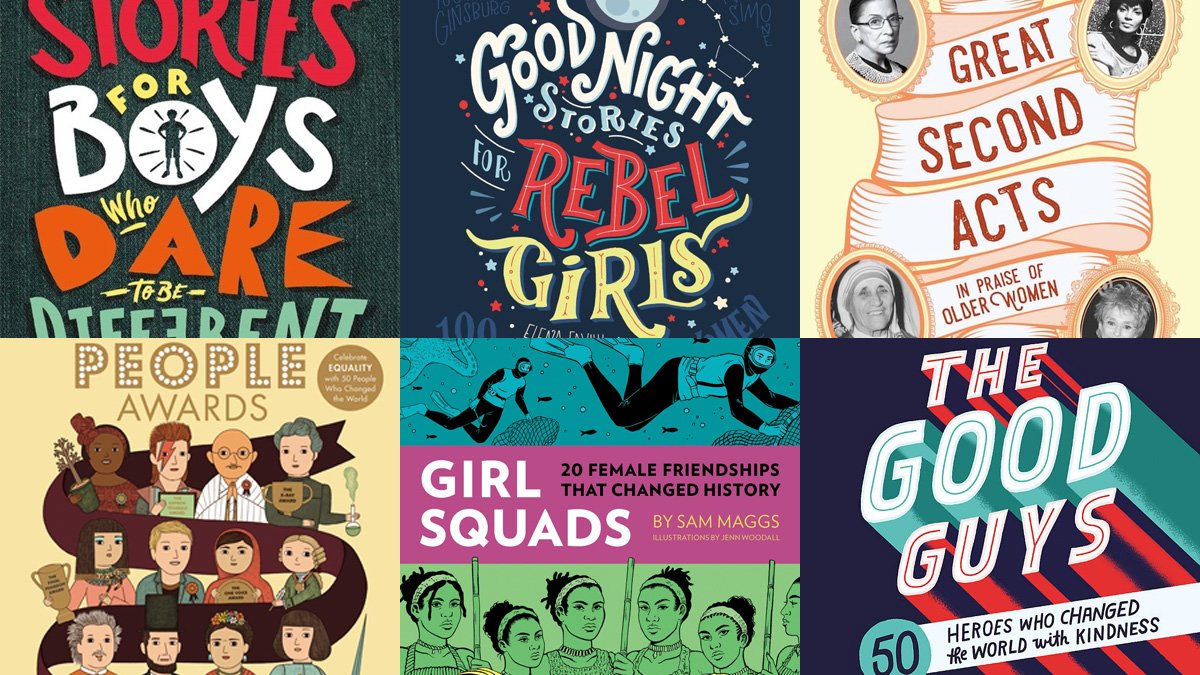
Beginning with the publication of Goodnight Stories for Rebel Girls, there has been an influx of biographical vignette books which introduce a host of famous people to their readers through short chapters focusing on different individuals. There are dozens of these books now, all with a specific focus on different groups of women and men, and during 2018 I have read and reviewed several other titles that feature groups such as women in the space industry, music legends, women of Star Wars, and more.
I’ve recently read seven more of these biographical vignette books that I wanted to share with you. Many of these books also focus on specific groups of people such as men who have demonstrated kindness, women who achieved great things at a late age, and groups of female friends who worked together to achieve greatness.
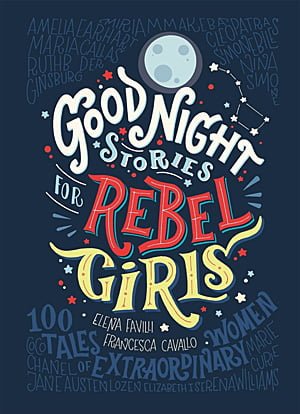
Goodnight Stories for Rebel Girls Volumes One and Two
One of the first of this new genre of biographical vignette books, Goodnight Stories for Rebel Girls, was “the most funded original book in the history of crowdfunding” and is easily the most well-known title in this collection. Both volumes include 100 biographies of amazing women, although you might be familiar with more of the faces in volume one than volume two. Each woman gets a full page biography and a full-page portrait, drawn by one of the many female artists around the world who were hired to create the art for these books.
While Rebel Girls might be the original, personally, I don’t think these two titles are necessarily the best. The “once upon a time” opening for many of the bios became grating after a while and I felt it trivialized the achievements of many of the women in its pages. Many of the bios also felt rushed, as if the authors wanted to pack far more into the page than they had space for and didn’t know what to cut and what to leave in.
I also noticed that the bios often didn’t tell the women’s full story. While you will never fit a person’s whole life into a single page—especially not with such remarkable women—some of the missing facts are too vital to these stories to have been left out. Take the entry for the Mirabal Sisters, four sisters from the Dominican Republic who opposed the dictator who ruled their country. Their bio states that “the sisters’ courage inspired Dominicans and gave them strength to oppose Trujillo’s regime,” but I happened to notice that three of the sisters shared the same date of death and did a little internet research, which is where I discovered that they had been assassinated for their activism—a fact that I feel should absolutely have been included.
These are beautiful books and packed with more bios than many of the others, but I found myself wishing that those bios were that little bit more fleshed out

The Good Guys: 50 Heroes Who Changed the World With Kindness
The Good Guys by Rob Kemp and Paul Blow does exactly what its title suggests, introducing 50 famous men who have changed the world through acts of philanthropy, engineering, protest, and more. Each guy gets a one-page bio and an illustrated portrait—pretty standard in these types of books—and the bios themselves are short and sweet, however, this doesn’t mean they’re scant on details. Each of the bios is carefully compiled so as to allow lots of information about each man and his deeds to be included, both his “kind” actions which earned him a place in the book and his other works such as sport, acting, politics, and more.
There are plenty of names you would expect to see included here such as Martin Luther King Jr, Oskar Schindler, and Nelson Mandela, and there is some significant crossover with the 40 people featured in People of Peace, but the book also throws in lots of other, more surprising choices. Sir Patrick Stewart is included for his campaigning against domestic violence, Sir Tim Berners-Lee for his creation of the World Wide Web, and John Boyega for his work with impoverished kids in London and Nigeria. There is a strong focus toward British men here, with people like Jamie Oliver and Professor Green included, but the book does include people from all over the world, such as Colin Kaepernick, Didier Drogba, and Ban Ki-moon.
A few reviews of this book have asked why we need a book specifically focused on celebrating men’s achievements when the world already seems set up to do so continuously, but I disagree. This is a wonderful book that celebrates men for being kind, helping others, and serving their communities. I hope it will be an inspiration to many young boys and help to show them that kindness and non-violence can be masculine and that even tough guys can help others too.
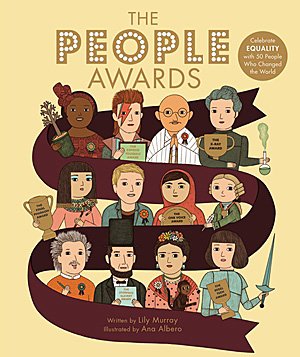
The People Awards
The People Awards by Lily Murray celebrates 29 men and women from across the world who have achieved something great. Each person is given an award—the Curiosity Award for Einstein, the Saving Lives Award to Louis Pasteur—and their bio introduces them very briefly along with the reasons why they have won their award. Each bio is illustrated with a portrait of the person, and their second page is designed to look like a collection of photographs showing them at important moments of their lives.
This was probably my least favorite of the bunch. I wasn’t taken with the art style and I felt that the lack of any particular focus such as women, Australians, musicians, etc meant that the book was rather haphazard and unfocused. The people were introduced at random instead of being in chronological or any other kind of order, and were simply too much of a mixed bag—why these particular people out of so many possible choices?
The Awards were often oddly specific too—J.K. Rowling won the Most Magical Muggle Award, Marie Curie the X-Ray award, and Pele the 1279 Goals Award. No one else is going to be eligible to “win” these, so they end up feeling less like an award and more an excuse to include them. I would have preferred to see a set of vaguer awards—scientific achievement, athletic achievement, etc—with a person chosen to win these from all those who would be eligible, although choosing a single person to win such prizes when your pool of potential winners isn’t narrowed down by the focus of the book and instead includes everybody who has ever lived presents its own challenge.
The book does do a good job of including people from a range of nationalities, although people of color are once again significantly outnumbered by whites. There were also some names included here that I haven’t seen in the other books, such as Olaudah Equiano, Vincent Lingiari, and Mary Anning, but these just couldn’t make up for the overly random nature of the book.
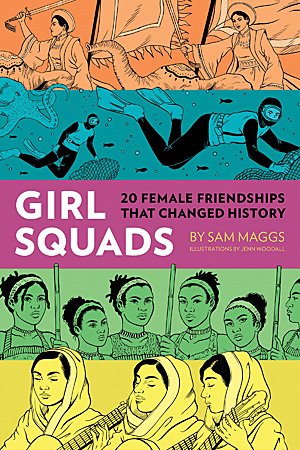
Girl Squads
Written by Sam Maggs (whose Fangirl’s Guide to the Galaxy I loved when I read it several years ago), Girl Squads is a collection of biographical vignettes that focus on groups of women, including sisters, friends, *ahem* “gal-pals,” colleagues, and more. Rather than focusing specifically on an individual women’s achievements, it instead looks at the way women can empower one another to do great things when they have a squad of other awesome women behind them.
It is easily the most colloquial of all the books, leading to the sensation that you’re sat sharing drinks with Sam as she chats away about the amazing women she has learned about that day. It’s filled with snark, sarcasm, and nerdy references—in the chapter about the women of SCOTUS, Sam tells us that “when their judicial superpowers combine, they become the VOLTRON of powerful female friendships”—which makes it a whole lot of fun to read. The bios in this book are also the longest by far, with each Squad receiving a full chapter over several pages to cover its exploits. This means that you can’t dip in and out nearly as quickly as you can with the other books but makes it great if you want something that little bit more thorough without reading a full-length biography.
This book also contained some of the least famous women included across all the books here, which made it very refreshing. The 1964 Japanese Women’s Volleyball Team, the Patriotic Women’s League of Iran, the Haenyeo Free-Divers of the Korea Strait, and the Trobairitz Feminist Musicians of Medieval France might not be the first groups that spring to your mind when you think of inspiring girl groups, but their stories are amazing and deserve to be better known. The book is divided into five sections, Athlete Squads, Political and Activist Squads, Warrior Squads, Scientist Squads, and Artist Squads, which gives you an idea of the variety of achievements covered in its pages.
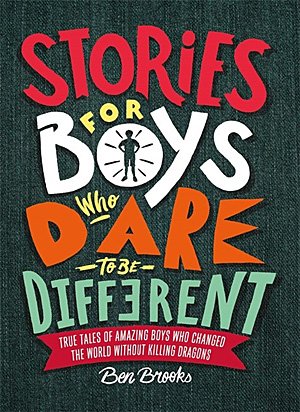
Stories for Boys Who Dare to Be Different
Stories For Boys Who Dare to Be Different by Ben Brooks ended up being one of my favorites in this bunch for a number of reasons. With 100 profiles included, it was bursting with men from across history and around the globe, and it was fairly diverse too, with around a third of the profiles featuring POC and indigenous peoples.
There was a huge variety of different people included: actors, philanthropists, inventors, chefs, royalty, sportsmen, and much more, and every profile felt longer than its short length would suggest. I felt as if I received a good introduction to each man after reading it, unlike with several other titles that left me wanting to know more. It was also highly up-to-date with events from this year covered in its pages.
I really enjoyed the artwork here as well. All the art is created by Quinton Winter (Vertigo Comics, 2000AD), and each portrait shows its subject in the context of their achievements rather than being a simple portrait against a plain backdrop. The portraits for Steven Spielberg, Salvador Dali (drawn in his own style), Percy Shelley, and Neil Degrasse Tyson were some of my favorites.
Of course, its always possible with these books to create an equally long list of people who you feel should have been included (“But what about X???”), but with this particular volume, I felt that it did a great job of covering a great selection. A second volume—Stories for Kids Who Dare to Be Different—featuring both men and women has been recently published, and I can’t wait to read it.
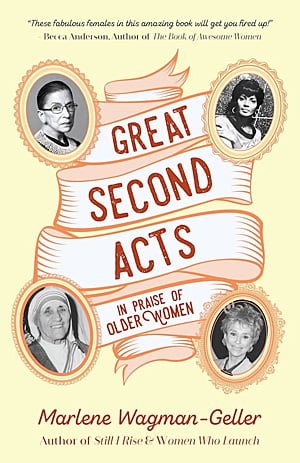
Great Second Acts: In Praise of Older Women
The last of my selection of biographical vignette books, Great Second Acts, sells itself as “a fascinating collection of biographical vignettes of dozens of women of a certain age who have excelled, inspired, and achieved.” I took this to mean that it would feature women who came to prominence in their various fields of achievement at an age when our culture suggests they had already had their day, thus showing women that it’s never too late to succeed. Instead, the book seemed a little confused about its subject matter because while some of the women in its pages didn’t rise up until later in life, many of them had been famous since their teens and twenties, or even—in the case of Shirley Temple—since prepubescence.
That isn’t to say that this is not a good book. The biographies contained here are detailed and don’t hold back on the darker parts of these women’s lives, painting a full picture of how they came to be such inspirational figures. There’s also a good variety of faces here including many I hadn’t read about in any of the previous volumes, such as Moms Mabley, Mary Kay Ash, and Edith Windsor, alongside more familiar faces like Ruth Bader Ginsberg and Nichelle Nichols. The majority seemed to have been chosen for their humanitarian and activist work later in life, but there were others too, such as Judge Judy. Interestingly, the blurb for the book on Amazon mentions bios of Margaret Thatcher, Gloria Steinem, Ruth Handler, and Julia Child, none of whom were included in my copy.
I found that Great Second Acts was one of the more difficult books of this collection to read due to some factors that could easily have been solved in editing. The chapters have odd headings that don’t reveal who you are reading about (for example, Jane Fonda’s chapter is titled, “Atticus Finch,” purely due to a comment about her father by the author) and the writing style meant that I was often several paragraphs into a bio before figuring out who I was reading about, especially when the woman in question had changed some or all of her name before becoming famous. The bios also jump around in the subject’s personal timeline so much that it becomes hard to follow what’s going on; in Simone Veil’s bio, we jump from 2005 to 1952 to 2002 to 2013 within three sentences.
This is a book with a great premise, but it could have done with a firmer hand in the editing process. That being said, I still believe it will make a great gift this holiday season, especially for a woman who fears that she may be aging faster than she can accomplish her dreams and worries that time is running out because all these women show that time is never a factor if you stay determined.
GeekMom received several of these books for review purposes.


